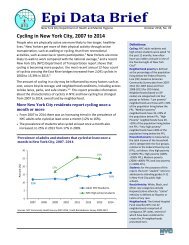2013-dot-sustainable-streets-lowres
2013-dot-sustainable-streets-lowres
2013-dot-sustainable-streets-lowres
Create successful ePaper yourself
Turn your PDF publications into a flip-book with our unique Google optimized e-Paper software.
SAFETYData and design analysis have beenkey factors in DOT’s success in pushingtraffic deaths to historic lowsA NEW ANALYTIC FOUNDATIONMOTOR VEHICLE OCCUPANT FATALITIES BYCAUSE AND LOCATION, 2012NYCDOT established a new basis for safety analysis with its seminal2010 Pedestrian Safety Study & Action Plan. NYCDOT researchersexamined dozens of factors and a wide variety of datasets from over7,000 severe and fatal pedestrian crashes in New York City during2002–2006 that could be associated with each pedestrian injuryand with the number of injuries in given geographic areas. Variableswith significant levels of correlation with pedestrian crashes wereidentified, then used to build a carefully designed statistical model.Experts from NY University, Rensselaer Polytechnic Institute andSUNY Buffalo supported the effort.The state–of–the–art data statistical modeling techniques usedattempted to control for pedestrian exposure to crashes, using factorslike population, vehicle registrations, presence of traffic signals(generally located at higher–volume intersections) and transit usage.The study used two distinct approaches to modeling: crash frequencyanalysis and crash severity analysis. Crash frequency analysis aims todetermine the causes of a high frequency crash location, while crashseverity analysis aims to determine why some crashes resulted in asevere injury, while others resulted in a fatality.The vast size and diversity of New York City’s street network andneighborhoods presented a robust opportunity for this advancedanalysis, as crash rates could be compared across neighborhoodsthat differ by a wide variety of characteristics but contain very similargeometric dimensions and engineering treatments.The Action Plan accompanying the pedestrian safety studysummarized its findings, some of which are shown here. The analysiscontinues to inform DOT’s annual set of street improvement projects.Highway–Other CausesLocal StreetsOther CausesHighway–Speeding11%18%26%PEDESTRIAN ACTION AT TIME OF CRASHCROSSING WITH SIGNALCROSSING, NO SIGNAL OR SIDEWALKCROSSING AGAINST SIGNALOTHER ACTIONS IN ROADWAYEMERGED FROM BEHIND PARKED VEHICLECROSSING, NO SIGNAL, MARKED CROSSWALKNOT IN ROADWAYPLAYING IN ROADWAYGETTING ON/OFF VEHICLEWORKING IN ROADWAY45%Local Streets–SpeedingPEDESTRIAN ACTION SEVERE FATAL TOTAL %TOTAL1,589 123 1,712 26.9%1,3381,155399401327204888366168146833837303151,5061,301 20.4%482 7.6%43936423491847123.6%6.9%5.7%3.7%1.4%1.3%1.1%ALONG HIGHWAY WITH TRAFFIC416470.7%ALONG HIGHWAY AGAINST TRAFFIC245290.5%CHILD GETTING ON/OFF SCHOOL BUS8190.1%34Chapter 2: The Science of Safety



